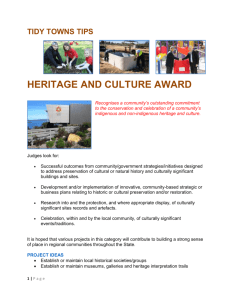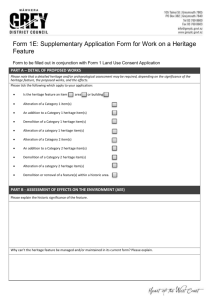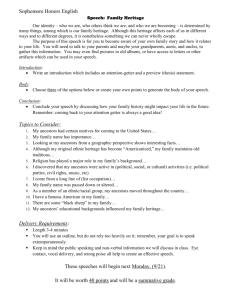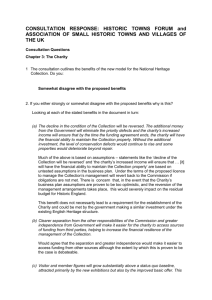Word - Arts Council England
advertisement
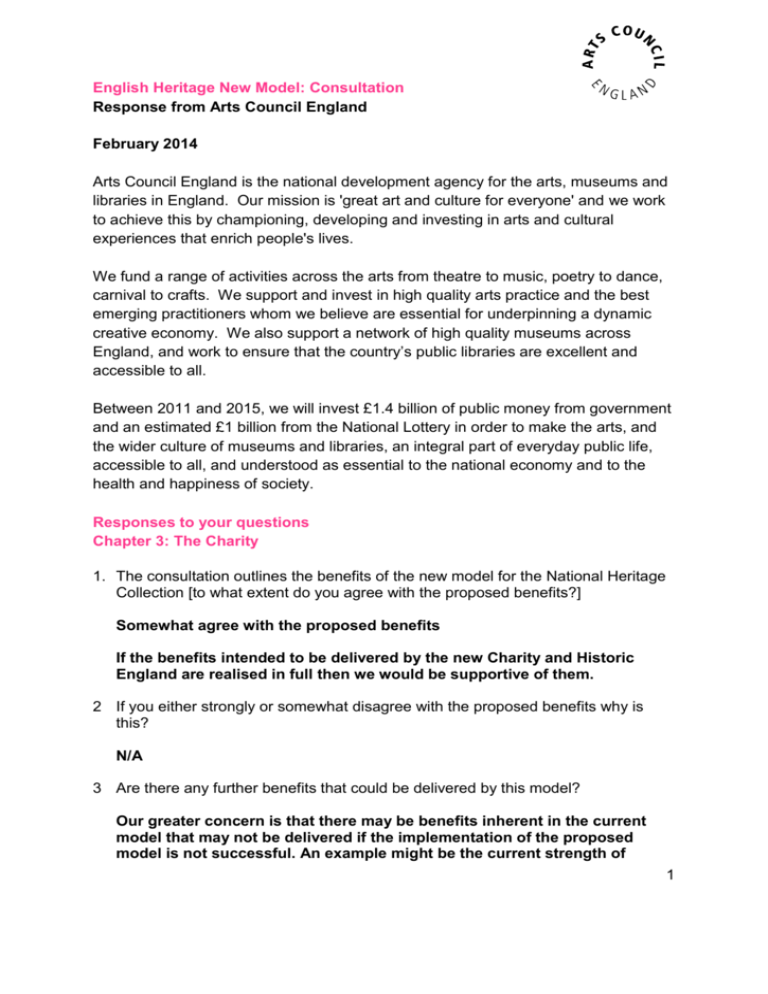
English Heritage New Model: Consultation Response from Arts Council England February 2014 Arts Council England is the national development agency for the arts, museums and libraries in England. Our mission is 'great art and culture for everyone' and we work to achieve this by championing, developing and investing in arts and cultural experiences that enrich people's lives. We fund a range of activities across the arts from theatre to music, poetry to dance, carnival to crafts. We support and invest in high quality arts practice and the best emerging practitioners whom we believe are essential for underpinning a dynamic creative economy. We also support a network of high quality museums across England, and work to ensure that the country’s public libraries are excellent and accessible to all. Between 2011 and 2015, we will invest £1.4 billion of public money from government and an estimated £1 billion from the National Lottery in order to make the arts, and the wider culture of museums and libraries, an integral part of everyday public life, accessible to all, and understood as essential to the national economy and to the health and happiness of society. Responses to your questions Chapter 3: The Charity 1. The consultation outlines the benefits of the new model for the National Heritage Collection [to what extent do you agree with the proposed benefits?] Somewhat agree with the proposed benefits If the benefits intended to be delivered by the new Charity and Historic England are realised in full then we would be supportive of them. 2 If you either strongly or somewhat disagree with the proposed benefits why is this? N/A 3 Are there any further benefits that could be delivered by this model? Our greater concern is that there may be benefits inherent in the current model that may not be delivered if the implementation of the proposed model is not successful. An example might be the current strength of 1 linking the care of the National Collection and its requirement for accessing expertise with the delivery of English Heritage’s statutory functions for caring for and protecting heritage. Whilst it is understood that there may be challenges with the current arrangements which the proposed structure seeks to redress, there are also inherent advantages in being seen to ‘practice what you preach’, so to speak, in terms of English Heritage’s credibility. 4 Are there any other key opportunities for the charity to increase earned income in addition to those outlined in the consultation? Don’t Know It is not clear that there is enough information currently contained within the consultation document about the extent and type of proposed opportunities to identify additional missing ones at this stage. More information about this would be welcome in support of the proposal. 5 If yes what are they? N/A 6 What aspects of the current service provided to the public by English Heritage in relation to the National Heritage Collection is it important that the charity maintains? The proposed charitable objectives for the new charity seem to encompass the activities that it is essential to maintain. E.g.: Securing the conservation of the National Heritage Collection. Advancing the public’s knowledge and enjoyment of the National Heritage Collection. Providing educational facilities and services, instruction and information to the public in relation to the National Heritage Collection. We believe that it is essential that the public are reassured that the proposed arrangements do not endanger the security of public ownership of the National Collection, do not reduce the government’s interest in securing its future and that the commitment to intervene on behalf of heritage of particular importance where necessary as the home of last resort will be maintained. 7 What are the opportunities to further enhance the services that will be offered by the charity? We clearly do not yet have a complete picture of the financial modelling, assumptions and testing that is underpinning the proposals. If the proposed projections for increases in visitor numbers and income prove to 2 be correct then it is fair to assume that this will bring challenges and opportunities for the services the charity provides. There will be a need to invest further in the infrastructure and ‘offer’ at each site in order to maintain visitors, repeat visitors and sustain membership. At the same time success will bring challenges in terms of wear and tear on the National Collection sites and the need to carefully balance the requirement to entertain the visitors who are sustaining the charity and the need to care for the collection which must remain at the core of the organisations purpose. 8 Do you agree that the suggested charitable objectives are broadly the right ones? Yes 9 If no, what changes to them do you think should be made? N/A 10 Are the proposed success criteria to measure the performance of the charity and to ensure that the benefits are realised the right ones? The proposed success criteria are good ones but might be added to. See 11. 11 If not what else should be included in the success criteria? The effectiveness of the relationship between the Charity and Historic England, particularly in discussions around sites at risk and of agreed national importance will be key to the perceptions of the success of the new arrangements. The measure of public trust in the charity’s ongoing ability to focus on the care of the National Collection will also be important. Chapter 4: Historic England 12 We are interested in the views of respondents to the proposed future opportunities and priorities for Historic England. Are these the right priorities and opportunities? Is there anything missing? It is notable that Chapter 4 of the consultation document, dealing with Historic England, is a little ‘thinner’ than the section devoted to the charity, though this is presumably on the assumption that the intention is to maintain the delivery of current services in full. We would fully support the statement that it is important for Historic England to continue to be a confident independent organisation to help sustain our national quality of life and to secure economic benefits. We also recognise the importance of engagement and participation in our national 3 heritage, encouraging communities to come together in caring for and about their heritage assets. As an NDPB delivering our own statutory functions around cultural property and wider responsibilities for museum development and standards, we recognise the need for Heritage England’s advice to remain expert and impartial, constructive, visionary and proactive and with the ability to publically champion and celebrate England’s historic environment and those who look after it. It will be critical that Historic England are funded sufficiently to carry out their essential role and are not perceived to be more vulnerable as a result of the proposed changes. The continued focus on the National Heritage Protection plan seems like the right approach. At the moment English Heritage, alongside law enforcement agencies and partners such as Arts Council England, has an important role to play in raising awareness of and combating criminal activity against cultural property. We would be reassured to know that this will remain a priority under the new structure and how this sits with the roles of the charity and Historic England respectively. 13 Are the proposed success criteria to measure the performance of Historic England the right ones? Yes 14 If not what else should be included in the success criteria? N/A 15 Should the National Heritage Protection Plan form the basis of the business plan for Historic England? Yes 16 If no – why not? N/A 17 Are there any further points you would like to add in relation to the consultation? We will be interested to see further financial modelling in support of the proposal as it is developed. For example, around the evidence that suggests that the current rate of visitor and income growth will be sustainable for a further 8 years and what the increased expenditure would be as required to sustain sites which are more used and where more is expected? 4 We note that the consultation has relatively little detail around the practical elements of the shared services and infrastructure between the organisations and how that will be disentangled over time. About you section 18 Are you responding as an individual or on behalf of an organisation? Part of an organisation 19 If you are responding on behalf of an organisation what best describes the type of organisation? Other (please specify) Non-Departmental Public Body (NDPB) 20 If you are responding as an individual are you an existing English Heritage member and/or volunteer? No 21 Are you an owner of a listed building? No Response by: Arts Council England 14 Great Peter Street Westminster London SW1P 3NP We consent to our response being made public. 5






